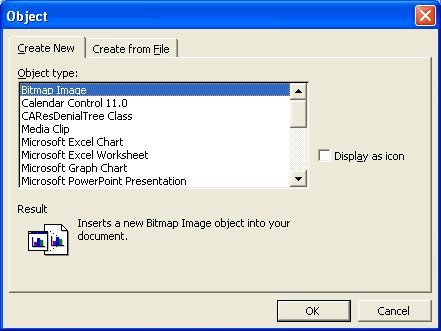Written by Allen Wyatt (last updated April 29, 2023)
This tip applies to Word 97, 2000, 2002, and 2003
One way you can put fractions in your document is to use the Equation Editor provided with Word. This tool allows you to create all sorts of mathematical formulae in your document, including fractions. Unfortunately, the Equation Editor is not installed by default, so you may need to run the Word or Office Setup program to make sure it is installed.
To insert a fraction with the Equation Editor, follow these steps:

Figure 1. The Object dialog box.
Some people don't particularly care to use the Equation Editor, because it adds another level of complexity to working with Word. (It is always helpful to know how to use the menus and templates in the Equation Editor, and that means more learning.) However, when it comes to complex fractions and other mathematical formulae, it is the best tool at hand. (There are third-party tools that allow you even greater control over equations, including Math Type, which is an upgrade to the Equation Editor provided with Word.)
WordTips is your source for cost-effective Microsoft Word training. (Microsoft Word is the most popular word processing software in the world.) This tip (1804) applies to Microsoft Word 97, 2000, 2002, and 2003.

Do More in Less Time! An easy-to-understand guide to the more advanced features available in the Microsoft 365 version of Word. Enhance the quality of your documents and boost productivity in any field with this in-depth resource. Complete your Word-related tasks more efficiently as you unlock lesser-known tools and learn to quickly access the features you need. Check out Microsoft 365 Word For Professionals For Dummies today!
The Equation Editor is a great way to add a professional-looking equation to your document. It allows you to modify many ...
Discover MoreThe equation editor is a great tool for adding mathematical equations into your document. The placement of many elements ...
Discover MoreYou can define styles for different characters used in the Equation Editor. It is not as full-featured as styles in Word, ...
Discover MoreFREE SERVICE: Get tips like this every week in WordTips, a free productivity newsletter. Enter your address and click "Subscribe."
There are currently no comments for this tip. (Be the first to leave your comment—just use the simple form above!)
Got a version of Word that uses the menu interface (Word 97, Word 2000, Word 2002, or Word 2003)? This site is for you! If you use a later version of Word, visit our WordTips site focusing on the ribbon interface.
Visit the WordTips channel on YouTube
FREE SERVICE: Get tips like this every week in WordTips, a free productivity newsletter. Enter your address and click "Subscribe."
Copyright © 2026 Sharon Parq Associates, Inc.
Comments